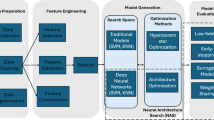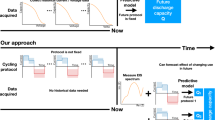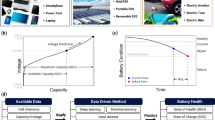Abstract
As Electric Vehicles (EVs) become increasingly prevalent, accurately estimating Lithium-ion Batteries (LIBs) Remaining Useful Life (RUL) is crucial for ensuring safety and avoiding operational risks beyond their service life threshold. However, directly measuring battery capacity during EV operation is challenging. In this paper, we propose a novel approach that leverages measurable features based on the discharge time and battery temperature to estimate RUL. Our framework relies on a novel feature extraction strategy that accurately characterizes the battery, leading to improved RUL predictions. Multiple machine learning algorithms are employed and evaluated. Our experimental results demonstrate that the proposed method accurately estimates capacity with minimal hyperparameter tuning. The \(R^2\) scores across various battery numbers indicate strong predictive performance for models like XGBoost, RF, AdaBoost, and others, with improvement percentages ranging from 85% to 99%, which the model’s generalizability verifies across other batteries. The results show the effectiveness of our proposed method in accurately estimating the RUL of LIBs in EVs.














Similar content being viewed by others
Data availability
Not applicable.
Code availability
Not applicable.
References
**ong J, Xu D (2021) Relationship between energy consumption, economic growth and environmental pollution in China. Environ Res 194:110718
Chen L, Zhang Y, Zheng Y, Li X, Zheng X (2020) Remaining useful life prediction of lithium-ion battery with optimal input sequence selection and error compensation. Neurocomputing 414:245–254
Zhang Y, Wang Z, Alsaadi FE (2020) Detection of intermittent faults for nonuniformly sampled multi-rate systems with dynamic quantisation and missing measurements. Int J Control 93(4):898–909
Šeruga D, Gosar A, Sweeney CA, Jaguemont J, Van Mierlo J, Nagode M (2021) Continuous modelling of cyclic ageing for lithium-ion batteries. Energy 215:119079
Cheng M, Sun H, Wei G, Zhou G, Zhang X (2022) A sustainable framework for the second-life battery ecosystem based on blockchain. Elsevier, Amsterdam
Tang T, Yuan H (2022) A hybrid approach based on decomposition algorithm and neural network for remaining useful life prediction of lithium-ion battery. Reliab Eng Syst Saf 217:108082
Sierra G, Orchard M, Goebel K, Kulkarni C (2019) Battery health management for small-size rotary-wing electric unmanned aerial vehicles: An efficient approach for constrained computing platforms. Reliab Eng Syst Saf 182:166–178
Liu Z, He B, Zhang Z, Deng W, Dong D, **a S, Zhou X, Liu Z (2022) Lithium/graphene composite anode with 3D structural LiF protection layer for high-performance lithium metal batteries. ACS Appl Mater Interfaces 14(2):2871–2880
Tang X, Zou C, Yao K, Chen G, Liu B, He Z, Gao F (2018) A fast estimation algorithm for lithium-ion battery state of health. J Power Sour 396:453–458
Ng SSY, **ng Y, Tsui KL (2014) A naive Bayes model for robust remaining useful life prediction of lithium-ion battery. Appl Energy 118:114–123
Wang S, ** S, Bai D, Fan Y, Shi H, Fernandez C (2021) A critical review of improved deep learning methods for the remaining useful life prediction of lithium-ion batteries. Energy Rep 7:5562–5574
Chen L, Ding Y, Liu B, Wu S, Wang Y, Pan H (2022) Remaining useful life prediction of lithium-ion battery using a novel particle filter framework with grey neural network. Energy 244:122581
Tian H, Qin P, Li K, Zhao Z (2020) A review of the state of health for lithium-ion batteries: research status and suggestions. J Clean Prod 261:120813
Lashgari F, Petkovski E, Cristaldi L (2022) State of health analysis for lithium-ion batteries considering temperature effect. In: 2022 IEEE International Conference on Metrology for Extended Reality, Artificial Intelligence and Neural Engineering (MetroXRAINE), IEEE, pp 40–45
Barcellona S, Cristaldi L, Faifer M, Petkovski E, Piegari L, Toscani S (2021) State of health prediction of lithium-ion batteries. In: 2021 IEEE International Workshop on Metrology for Industry 4.0 & IoT (MetroInd4. 0 &IoT), IEEE, pp 12–17
Zhang S, Zhai B, Guo X, Wang K, Peng N, Zhang X (2019) Synchronous estimation of state of health and remaining useful lifetime for lithium-ion battery using the incremental capacity and artificial neural networks. J Energy Storage 26:100951
Hu X, Xu L, Lin X, Pecht M (2020) Battery lifetime prognostics. Joule 4:310–346
Sulzer V, Mohtat P, Aitio A, Lee S, Yeh YT, Steinbacher F, Khan MU, Lee JW, Siegel JB, Stefanopoulou AG (2021) The challenge and opportunity of battery lifetime prediction from field data. Joule 5:1934–1955
Tian Y, Lin C, Li H, Du J, **ong R (2021) Detecting undesired lithium plating on anodes for lithium-ion batteries–a review on the in-situ methods. Appl Energy 300:117386
Yu B, Qiu H, Weng L, Huo K, Liu S, Liu H (2020) A health indicator for the online lifetime estimation of an electric vehicle power Li-ion battery. World Electr Veh J 11(3):59
Zhongwei D, Xu L, Liu H, Hu X, Duan Z, Xu Y (2023) Prognostics of battery capacity based on charging data and data-driven methods for on-road vehicles. Appl Energy 339:120954
Li J, Deng Z, Liu H, **e Y, Liu C, Chen L (2022) Battery capacity trajectory prediction by capturing the correlation between different vehicles. Energy 260:125123
Niri MF et al (2020) Remaining energy estimation for lithium-ion batteries via Gaussian mixture and Markov models for future load prediction. J Energy Storage 28:101271
Bui TMN et al (2021) A study of reduced battery degradation through state-of-charge pre-conditioning for vehicle-to-grid operations. IEEE Access 9:155871–155896
Niri MF et al (2020) State of power prediction for lithium-ion batteries in electric vehicles via Wavelet–Markov load analysis. IEEE Trans Intell Transp Syst 22(9):5833–5848
Song W, Wu D, Shen W, Boulet B (2023) A remaining useful life prediction method for lithium-ion battery based on temporal transformer network. Procedia Comput Sci 217:1830–1838
Sadabadi KK, ** X, Rizzoni G (2021) Prediction of remaining useful life for a composite electrode lithium ion battery cell using an electrochemical model to estimate the state of health. J Power Sour 481:228861
Ren L, Zhao L, Hong S, Zhao S, Wang H, Zhang L (2018) Remaining useful life prediction for lithium-ion battery: a deep learning approach. IEEE Access 6:50587–50598
Zraibi B, Okar C, Chaoui H, Mansouri M (2021) Remaining useful life assessment for lithium-ion batteries using CNN-LSTM-DNN hybrid method. IEEE Trans Veh Technol 70(5):4252–4261
Kara A (2021) A data-driven approach based on deep neural networks for lithium-ion battery prognostics. Neural Comput Appl 33(20):13525–13538
Toughzaoui Y, Toosi SB, Chaoui H, Louahlia H, Petrone R, Le Masson S, Gualous H (2022) State of health estimation and remaining useful life assessment of lithium-ion batteries: a comparative study. J Energy Storage 51:104520
Ardeshiri RR, Liu M, Ma C (2022) Multivariate stacked bidirectional long short term memory for lithium-ion battery health management. Reliab Eng Syst Saf 224:108481
Yao F, He W, Wu Y, Ding F, Meng D (2022) Remaining useful life prediction of lithium-ion batteries using a hybrid model. Energy 248:123622
Liu K, Shang Y, Ouyang Q, Widanage WD (2020) A data-driven approach with uncertainty quantification for predicting future capacities and remaining useful life of lithium-ion battery. IEEE Trans Ind Electron 68(4):3170–3180
Fan J, Fan J, Liu F, Qu J, Li R (2019) A novel machine learning method based approach for Li-ion battery prognostic and health management. IEEE Access 7:160043–160061
Saha B, Goebel K (2007) NASA Ames prognostics data repository. NASA Ames: moffett field, CA, USA, 2007. Available at: http://ti.arc.nasa.gov/project/prognostic-data-repository
Jafari S et al (2022) Lithium-ion battery health prediction on hybrid vehicles using machine learning approach. Energies 15(13):4753
Jafari S, Byun Y-C (2022) Prediction of the battery state using the digital twin framework based on the battery management system. IEEE Access 10:124685–124696
Shahbazi Z, Byun Y-C (2022) Blockchain and machine learning for intelligent multiple factor-based ride-hailing services. Comput Mater Contin 70(3):1–18
Qayyum F, Afzal MT (2019) Identification of important citations by exploiting research articles’ metadata and cue-terms from content. Scientometrics 118:21–43
Qayyum F et al (2022) Toward potential hybrid features evaluation using MLP-ANN binary classification model to tackle meaningful citations. Scientometrics 127(11):6471–6499
Qayyum F et al (2021) Towards potential content-based features evaluation to tackle meaningful citations. Symmetry 13(10):1973
Zhou D et al (2020) State of health monitoring and remaining useful life prediction of lithium-ion batteries based on temporal convolutional network. IEEE Access 8:53307–53320
Wei Y, Wu D (2023) Prediction of state of health and remaining useful life of lithium-ion battery using graph convolutional network with dual attention mechanisms. Reliab Eng Syst Saf 230:108947
Tang X et al (2023) Lithium-ion battery remaining useful life prediction based on hybrid model. Sustainability 15(7):6261
Funding
This research was financially supported by the Ministry of Small and Medium-sized Enterprises(SMEs) and Startups(MSS), Korea, under the “Regional Specialized Industry Development Plus Program (R &D, S3246057)” supervised by the Korea Technology and Information Promotion Agency for SMEs(TIPA). This work was also financially supported by the Ministry Of Trade, Industry & ENERGY(MOTIE) through the fostering project of The Establishment Project of Industry-University Fusion District).
Author information
Authors and Affiliations
Contributions
YCB contributed to Funding acquisition and Project administration; SJ contributed to Investigation, Methodology and Writing—review & editing. All authors have read and agreed to the published version of the manuscript
Corresponding author
Ethics declarations
Conflict of interest
The authors declare no competing interests.
Ethics approval
Not applicable.
Consent to participate
Not applicable.
Additional information
Publisher's Note
Springer Nature remains neutral with regard to jurisdictional claims in published maps and institutional affiliations.
Rights and permissions
Springer Nature or its licensor (e.g. a society or other partner) holds exclusive rights to this article under a publishing agreement with the author(s) or other rightsholder(s); author self-archiving of the accepted manuscript version of this article is solely governed by the terms of such publishing agreement and applicable law.
About this article
Cite this article
Jafari, S., Byun, Y.C. Accurate remaining useful life estimation of lithium-ion batteries in electric vehicles based on a measurable feature-based approach with explainable AI. J Supercomput 80, 4707–4732 (2024). https://doi.org/10.1007/s11227-023-05648-8
Accepted:
Published:
Issue Date:
DOI: https://doi.org/10.1007/s11227-023-05648-8




